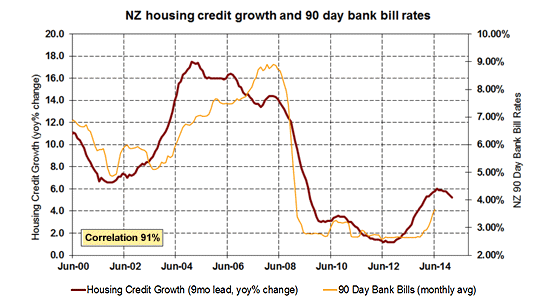
 By Roger J Kerr
By Roger J Kerr
The increase in the two and three year swap interest rates since the 12 June RBNZ Monetary Policy Statement has already delivered higher fixed rate mortgage lending rates from the banks.
The RBNZ should be happier at this development as they were clearly very frustrated with the reduction in the fixed lending interest rates over the March to June period when they were increasing the OCR.
However, the worries about a rampant residential property market fuelling inflation in nine to 12 months’ time do appear somewhat exaggerated to me.
Even before the latest mortgage rate increases there were signs that the upward momentum in the housing market was already waning.
Housing activity levels are moderating and prices follow the activity levels.
There are some key differences in the current up-cycle in the housing market to previous cycles that require closer consideration and deliberation by the RBNZ:
- Housing demand and price pressures are much more centred on the Christchurch and Auckland metropolitan markets for very specific reasons (earthquake rebuild and very low house construction in the four years after the GFC), whereas the 2005/2007 housing boom was nationwide. General demand-push inflation risks are therefore not as widespread.
- The LVR mortgage lending regulatory rules introduced by the RBNZ in October last years have been successful in taking the froth off the market, no such controls existed in earlier housing booms.
- The NZ dollar exchange rate has been high for longer through this housing cycle, keeping inflation lower as tradable deflation counteracts the inflation in the less competitive, non-tradable part of the economy. Much higher levels of FX forward hedging by importers this time around mean that even a 10% to 15% depreciation in the NZ dollar would not threaten the 2% annual inflation target over the next 12 months.
- Current strong net migration inflows have an entirely different make-up on this occasion compared to earlier cycles. The numbers and increase in new immigrant arrivals needing a house is a lot less than the 2002 to 2006 period. The current big jump in net migrant numbers is due to a collapse in the number of Kiwi’s permanently leaving which has a much less direct impact on housing demand (i.e. the 24 year old staying flatting instead of leaving for the mining job in Australia).
- Outside Christchurch and some parts of Auckland there is no real upward pressure on residential rents and thus no major inflationary pressures from this source.
- Housing credit growth appears to have already peaked at +4% on this cycle (see chart below), considerably less than the +16% credit expansion witnessed in 2006/2006. I just do not see the “wealth-effect” from higher house prices fuelling rampant consumer spending that causes retailers to increase prices as the punters have so much money they do not care about the price. The consumer patterns and sentiment today seem more focussed on cheaper overseas holidays and the household electronic toys continue to fall in price due to the high currency.
In my view, the RBNZ economists in the last MPS have over-reacted to strong immigration numbers and concluded that future inflation risks had increased.
The above points suggest that they should not be so mechanical on reaching such conclusions.

-----------------------------------------------------------
To subscribe to our daily Currency Rate Sheet email, enter your email address here.
Daily swap rates
Select chart tabs
Roger J Kerr is a partner at PwC. He specialises in fixed interest securities and is a commentator on economics and markets. More commentary and useful information on fixed interest investing can be found at rogeradvice.com

We welcome your comments below. If you are not already registered, please register to comment.
Remember we welcome robust, respectful and insightful debate. We don't welcome abusive or defamatory comments and will de-register those repeatedly making such comments. Our current comment policy is here.